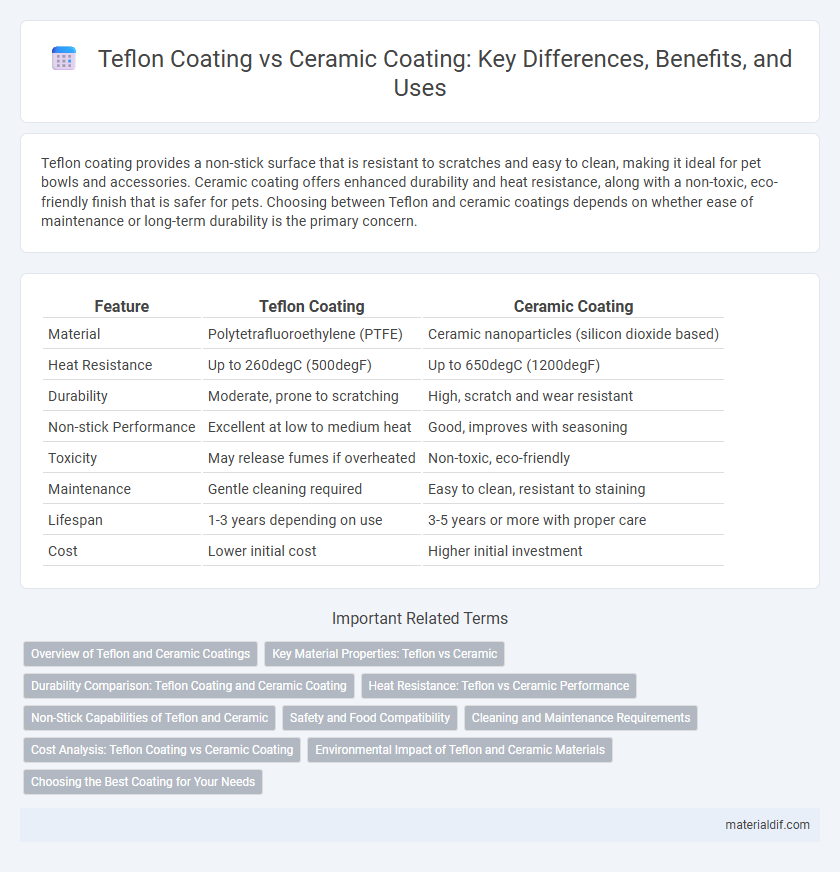Teflon coating provides a non-stick surface that is resistant to scratches and easy to clean, making it ideal for pet bowls and accessories. Ceramic coating offers enhanced durability and heat resistance, along with a non-toxic, eco-friendly finish that is safer for pets. Choosing between Teflon and ceramic coatings depends on whether ease of maintenance or long-term durability is the primary concern.
Table of Comparison
| Feature | Teflon Coating | Ceramic Coating |
|---|---|---|
| Material | Polytetrafluoroethylene (PTFE) | Ceramic nanoparticles (silicon dioxide based) |
| Heat Resistance | Up to 260degC (500degF) | Up to 650degC (1200degF) |
| Durability | Moderate, prone to scratching | High, scratch and wear resistant |
| Non-stick Performance | Excellent at low to medium heat | Good, improves with seasoning |
| Toxicity | May release fumes if overheated | Non-toxic, eco-friendly |
| Maintenance | Gentle cleaning required | Easy to clean, resistant to staining |
| Lifespan | 1-3 years depending on use | 3-5 years or more with proper care |
| Cost | Lower initial cost | Higher initial investment |
Overview of Teflon and Ceramic Coatings
Teflon coating, based on polytetrafluoroethylene (PTFE), offers non-stick properties, chemical resistance, and low friction, commonly applied in cookware and industrial equipment. Ceramic coating, composed of silicon dioxide (SiO2) derived from sand, provides superior heat resistance, hardness, and durability suitable for automotive and protective surfaces. Both coatings enhance surface performance but differ in thermal tolerance, wear resistance, and environmental impact, defining their optimal applications.
Key Material Properties: Teflon vs Ceramic
Teflon coating offers excellent non-stick properties and chemical resistance due to its polytetrafluoroethylene (PTFE) composition, making it ideal for cookware and industrial applications. Ceramic coatings provide superior hardness and scratch resistance as they are typically made from silicon dioxide-based materials, enhancing durability and heat resistance. Both materials excel in different key properties, with Teflon focusing on low friction and chemical inertness, while ceramic emphasizes toughness and thermal stability.
Durability Comparison: Teflon Coating and Ceramic Coating
Teflon coatings provide a smooth, non-stick surface but generally offer less durability compared to ceramic coatings, which are known for their high resistance to scratches, heat, and chemicals. Ceramic coatings create a robust, long-lasting protective layer that can extend the lifespan of surfaces by several years, whereas Teflon coatings may wear off faster under regular use. For applications requiring strong durability and longevity, ceramic coatings are typically the preferred choice over Teflon coatings.
Heat Resistance: Teflon vs Ceramic Performance
Teflon coating offers good heat resistance up to approximately 260degC (500degF) but begins to degrade and release fumes beyond this temperature. Ceramic coating withstands much higher temperatures, often exceeding 450degC (842degF), maintaining structural integrity and non-stick properties under extreme heat. This makes ceramic coatings more suitable for high-heat cooking applications compared to Teflon coatings.
Non-Stick Capabilities of Teflon and Ceramic
Teflon coating offers superior non-stick capabilities due to its polytetrafluoroethylene (PTFE) composition, allowing food to release easily and minimizing the need for oil or butter. Ceramic coatings provide a natural non-stick surface derived from inorganic minerals, offering decent release properties but typically requiring more careful maintenance to prevent sticking. Compared to ceramic, Teflon's non-stick performance remains more consistent and durable under prolonged cooking conditions.
Safety and Food Compatibility
Teflon coating is renowned for its excellent non-stick properties and safety in cookware when used at recommended temperatures, preventing food from sticking and reducing the need for oil. Ceramic coating is a non-toxic alternative, free from PTFE and PFOA, offering superior heat resistance and better durability but may be more prone to chipping over time. Both coatings ensure food compatibility, but ceramic's chemical-free composition makes it a preferred choice for those prioritizing health-conscious cooking.
Cleaning and Maintenance Requirements
Teflon coating offers superior non-stick properties that simplify cleaning by preventing food from adhering to surfaces, requiring only gentle wiping with a soft sponge and mild detergent. Ceramic coating, while also providing a smooth surface, tends to be more scratch-resistant but may need more frequent cleaning to prevent residue buildup due to its porous structure. Both coatings demand avoidance of abrasive cleaners and metal utensils to maintain their longevity and effectiveness.
Cost Analysis: Teflon Coating vs Ceramic Coating
Teflon coating typically costs between $10 to $30 per square foot, making it a more affordable option compared to ceramic coating, which ranges from $25 to $100 per square foot due to its advanced durability and heat resistance. The lower upfront cost of Teflon coating appeals to budget-conscious consumers but may require more frequent reapplication, increasing long-term expenses. Ceramic coating's higher price is justified by its superior scratch resistance and longevity, often lasting several years without the need for renewal.
Environmental Impact of Teflon and Ceramic Materials
Teflon coating, made from polytetrafluoroethylene (PTFE), raises environmental concerns due to the release of perfluorooctanoic acid (PFOA) during production, which is persistent and bioaccumulative in ecosystems. Ceramic coatings, primarily composed of silicon dioxide or titanium dioxide, offer a more environmentally friendly alternative with non-toxic and biodegradable properties, reducing long-term ecological footprints. The inert nature of ceramic materials minimizes microplastic pollution, making them preferable for sustainable manufacturing and usage.
Choosing the Best Coating for Your Needs
Teflon coating offers excellent non-stick properties and chemical resistance, making it ideal for cookware that requires easy cleaning and durability under moderate heat. Ceramic coating provides superior heat tolerance and scratch resistance, suitable for high-temperature applications and scratch-prone surfaces. Selecting between Teflon and ceramic depends on your priorities: choose Teflon for effortless food release and chemical stability, or opt for ceramic if you need enhanced heat endurance and surface hardness.
Teflon Coating vs Ceramic Coating Infographic

 materialdif.com
materialdif.com